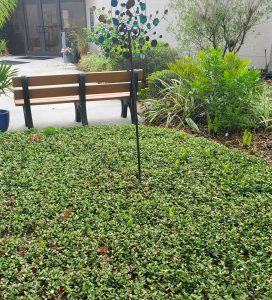
Asiatic jasmine is a common groundcover used in many local landscapes that can in fact make a nice turf alternative in selected sites. Actually, not related to jasmine – so don’t count on the flowers – Asiatic jasmine is a groundcover that is versatile and even comes in multiple cultivars well beyond the plan green type.
Asiatic jasmine is native to parts of Asia including Japan and Korea. This groundcover does well throughout Florida – and even a little northward – and is perfectly hardy in our area. The leaves are leathery, dark green in color, and no longer than two inches in size. One plant can spread to about three-feet wide, but only gets a little over a foot tall. As mentioned above, Asiatic jasmine is often considered a turf alternative and can be used where a lawn substitute is required. Although it may be used as a turf substitute, it does not like being walked on, so keep it restricted to low traffic areas with designated pathways to prevent trampling. While it can be mowed in the spring to neaten it up a bit, Asiatic jasmine seldom needs much trimming. It is moderately salt tolerant and can take some coastal conditions, but away from direct beach exposure. Its versatility as a groundcover includes full sun to part-shade conditions, moderate drought tolerance once established, hardiness to cold snaps, and its ability to grow well in containers and even hanging baskets.
Asiatic jasmine thrives on neglect once established. Install a new bed of Asiatic jasmine by placing transplants one and one-half feet apart on center. Although this groundcover will do well in sun or part-shade, part-shade conditions are preferred in our area unless otherwise noted. The “jasmine” part of the Asiatic jasmine is a very fragrant, but seldom-seen, pinwheel-like yellow flower.
I think that if you have the chance to use Asiatic jasmine as a groundcover, try to find the more colorful varieties. The dark-green original color is fine but jazz up the planting bed with cultivars sporting variegated white, pink, and orange foliage. Asiatic jasmine cultivars include ‘Snow-N-Summer’ which features pink, white, and green foliage, and ‘Gold Brocade’ with green leaves, variegated with light yellow and colored red orange on the new growth. Another cultivar ‘Summer Sunset’ does well in the sun with vibrant colors of green, yellow and red. There are more varieties available with enough to satisfy a collector, but you may to search on-line for the rarer cultivars.
Asiatic jasmine is relatively pest-free and does best with minimal irrigation once established. Over-irrigation can enhance wet conditions that may promote diseases such as aerial blight or Rhizoctonia – a fungal infection – to proliferate.
This groundcover is readily available at any garden center including some of the varieties mentioned above. Asiatic jasmine is good news for your landscape as it is a Florida-Friendly Landscaping™ recommended groundcover that will become a sustainable plant enjoyed for years to come! For more information on all types of groundcovers suitable for our area, or to ask a question, you can also call the Master Gardener Volunteer Helpdesk on Mondays, Wednesdays, and Fridays from 1 to 4 pm at 764-4340 for gardening help and insight into their role as an Extension volunteer. Ralph E. Mitchell is the Director/Horticulture Agent for UF/IFAS Extension – Charlotte County. He can be reached at 941-764-4344 or ralph.mitchell@charlottecountyfl.gov . Connect with us on social media. Like us on Facebook @CharlotteCountyExtension and follow us on Instagram @ifascharco.
Resources:
Asiatic Jasmine (2018) UF/IFAS Gardening Solutions. The University of Florida Extension Service, IFAS.
Gilman, E. F. (1999) Trachelospermum asiaticum. The University of Florida Extension Service, IFAS.
https://mrec.ifas.ufl.edu/rcb/Jasmine/introduction.htm – The Jasmine Project. The University of Florida Extension Service, IFAS.
The Florida-Friendly Landscaping™ Guide to Plant Selection & Landscape Design (2022) The University of Florida Extension Services
Gill, D. (2015) Problem with Asiatic Jasmine. The LSU AgCenter and the LSU College of Agriculture
Landre, C. Asiatic Jasmine – Trachelospermum asiaticum. South-Florida-Plant-Guide.com
Ayomide, M. (2023) The Complete Guide to Growing Asiatic Jasmine: Top 5 Cultivars to Select. Side Gardening – Plants and More.
Source: UF/IFAS Pest Alert
Note: All images and contents are the property of UF/IFAS.



